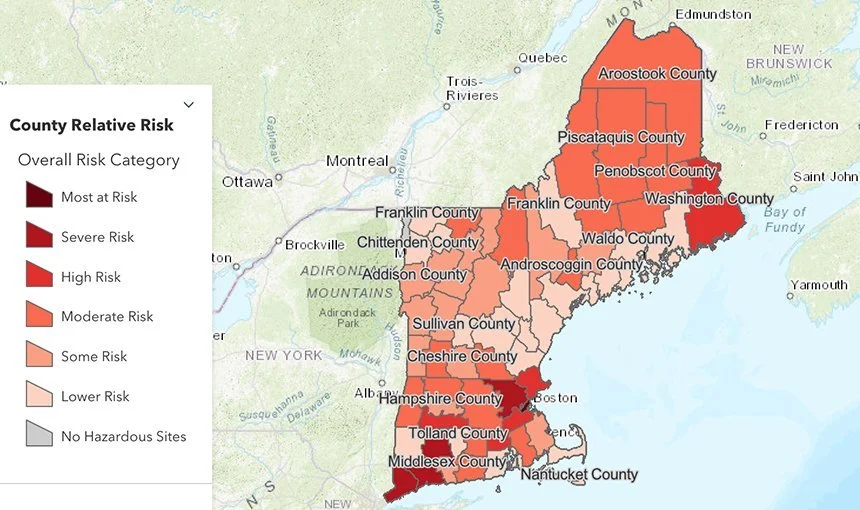
Caitlin Faulds: Trying to keep climate change from turning more toxic at N.E. waste sites
Providence County, in Rhode Island, and Suffolk County, in Massachusetts, are two of the most at-risk counties in New England from pollution buried at toxic sites.
— Conservation Law Foundation map
From ecoRI News (ecori.org)
Hazardous-waste sites and chemical facilities pockmark New England, leftovers of the region’s industrial past. And little action is being taken to prevent climate change from affecting these sites and cooking up a toxic future, according to analysts at the Conservation Law Foundation (CLF).
A regional report by CLF Massachusetts released this fall combined projections of climate risk with data on social vulnerability and hazardous- waste sites to build a comprehensive map of anticipated toxic-pollution risk from Connecticut to Maine. The results, which show that much of New England could face compounding threats, are startling — even to the mapmakers.
“I bought a house like six months ago … and was actually surprised by the number ... of [Superfund] sites that are in such close proximity to residential neighborhoods,” said Deanna Moran, CLF Massachusetts director of environmental planning. “It’s a little bit scary, but it’s a healthy amount of fear.”
In Rhode Island, Providence County was determined to be the county at highest risk, due to a combination of moderate wildfire risk, severe heat risk, high social vulnerability and 143 hazardous sites. Massachusetts’ s Suffolk County, which includes Boston, was deemed most at-risk in New England.
“A lot of people don’t realize how ubiquitous hazardous sites are, even Superfund sites are, throughout our region,” Moran said. “Even if a site is under remediation or fully remediated, those are the sites that we are still worried about because they were remediated without climate change at the forefront.”
The county-level analysis factors in risk associated with nearly 3,000 hazardous sites. These New England locations include landfills, Superfund sites, brownfields and 1,947 facilities across the region that generate large quantities of hazardous waste or are permitted for the treatment, storage or disposal of toxic chemicals. Many of these hazardous sites are aging, use failing technology, and/or do not have sufficient safeties in place to protect nearby communities in a warmer world, according to the CLF report.
“The techniques that we used to remediate those sites 20 years ago might not anticipate more extreme precipitation or flooding or heat,” Moran said, “and those are the ones that I think are really concerning ’cause they’re really not on the radar.”
Floods could damage infrastructure containing hazardous waste, trigger chemical fires, hinder technology monitoring toxic pollution, and create a toxic stew of floodwater and contaminants, according to the report. Rising temperatures could damage protective caps over contaminated properties and raise the toxicity level of some materials. Wildfires could ravage hazardous-waste sites, damaging protective infrastructure and releasing airborne contaminants.
The lineup of climate risks — which, according to CLF Massachusetts policy analyst Ali Hiple, were “weighted equally” in the report — paints a bleak scene of the region’s future, a future that has been glimpsed in isolated events across the country in recent years.
“Luckily, we have not seen that type of impact in the New England region yet, but we want to make sure that we’re being proactive now and not reactive later,” Moran said.
But despite knowing the dangers that climate poses, federal agencies “are not doing enough to address them, and that puts our communities in danger,” according to the CLF report. In 2019, a U.S. Government Accountability Office report suggested the Environmental Protection Agency should consider climate to ensure long-term Superfund site remediation and protection plans.
“We really just want to see the EPA really leading on this,” said Saranna Soroka, a legal fellow at CLF Massachusetts. “They’ve indicated they know the risk that climate change poses to these sites … but we want to see really consistent, really clear standards applied.”
Soroka noted that the federal agency could analyze climate impact as part of its existing Superfund-site review framework, which mandates site checks every five years. So far, climate analyses have not been incorporated, she said, despite EPA authority to do so.
“I think we’re well beyond the time of thinking through how we should be doing this,” Moran said. “We know the risks are real. In some cases, we’re already seeing them, and the time to be acting on them is now.”
Editor’s note: Here are links to EPA-designated Superfund sites in Rhode Island, Massachusetts, and Connecticut.
Caitlin Faulds is an ecoRI News journalist.
